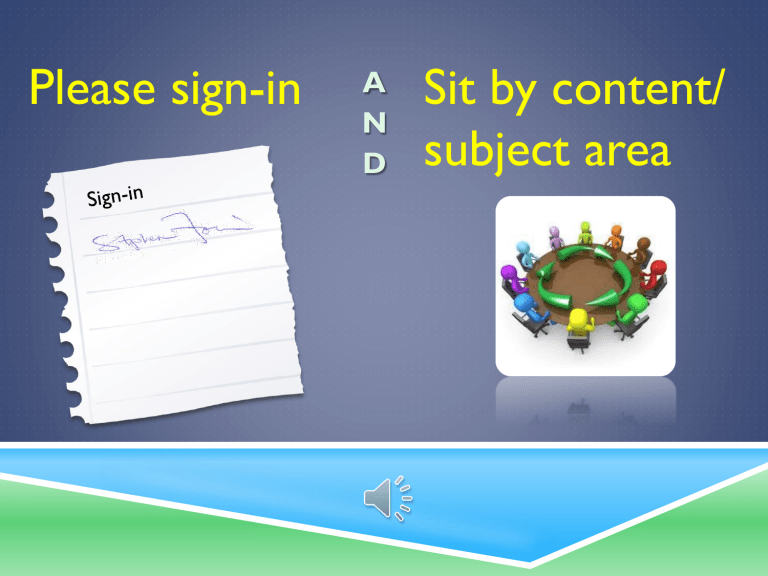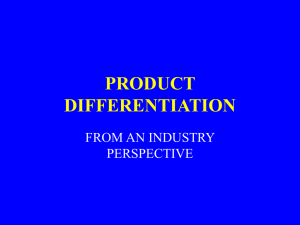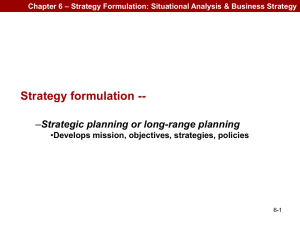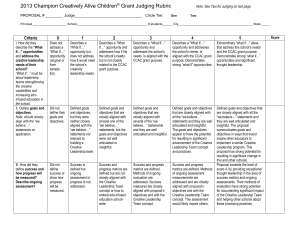Planning for Active Learning

Please sign-in
A
Sit by content/
N
D
subject area
Planning for Active Learning
THE LEARNING
TARGET
FRAMEWORK FOR
DOMAIN 1
November 5, 2013
SYNERGISTIC EFFECT
Learning
Target
(Overview)
Criteria for
Success
Domain 1:
Planning for
Active
Learning
Learning
Targets
POFU
OVERVIEW
Learning Targets
Performance of Understanding
Criteria for Success
THREE LEARNING
SEGMENTS
1
DIG DEEPER AND APPLY
Learning Targets
Performance of Understanding
Criteria for Success
2
3
ULTIMATE GOAL
I do some…
You do a little more…
SEGMENT 1:
LEARNING TARGET
I can understand the three components of the learning target framework.
I can show this by demonstrating the differences between a learning target, a performance of understanding and the criteria for success.
WEIGHING IN
• Pair up with two other people at your table for this activity
• One person in each triad take out your smartphone
• Go to TEXT MESSAGE
LEARNING TARGET
WHAT IS IT?
What is the NEW LEARNING for the DAY?
It’s what I am teaching – the mini-lesson content
HOW MIGHT IT BE WRITTEN?
I can…
LEARNING TARGET
I can develop an understanding of how squares and cubes are related.
PERFORMANCE OF UNDERSTANDING
WHAT IS IT?
What is the PRODUCT?
What will the kids do, say, write, create, etc.?
HOW MIGHT IT BE WRITTEN?
I can show this by…
PERFORMANCE OF UNDERSTANDING
I can show and explain how the number of sides on a square and the number of faces on a cube are related.
CRITERIA FOR SUCCESS
WHAT IS IT?
What makes a HIGH QUALITY product?
If your students did a perfect job on the POFU, what would that look like?
Think of language you might use on a rubric
HOW MIGHT IT BE WRITTEN?
I will know I am successful when I…
CRITERIA FOR SUCCESS
Show the correct number of sides for 5 squares.
Show the correct number of faces for 5 cubes.
Show/share an appropriate strategy.
Describe to a partner how the number of sides on a square is related to the number of faces on a cube.
TURN AND TALK
Which are Targets?
Which are Performances of Understanding ?
Which are Criteria for Success?
How do you know???
This is the statement…
I can participate in an investigation directing a beam of light at different materials.
I can explain the difference between opaque, translucent and transparent materials.
I can explain how different materials refract light in different ways.
I can explain what happens when light strikes transparent, translucent, or opaque objects.
Which component is it?
POFU
CS
LT
CS
I can categorize materials as transparent, translucent or opaque.
I can provide accurate and detailed responses to questions about refraction.
CS
CS
This is the statement…
I can complete # of problems on arrays and all partials independently.
I can work with partners to multiply whole numbers using place value blocks and record my work using short hand notes and arrays.
I can explain the solution to multiplication problems
Which component is it?
CS
POFU
CS
I can multiply multi-digit numbers by one, two and three digit numbers
LT
SEGMENT 1:
LEARNING TARGET
I can understand the three components of the learning target framework.
I can show this by demonstrating the differences between a learning target, a performance of understanding and the criteria for success.
3-2-1 – NOTE CARD
3 main components of the Learning Target
Framework
2 questions I still have about the components of the Learning Target Framework
1 phrase to describe my level of understanding of the components of the Learning Target
Framework
YOU DO…
CREATE A LEARNING TARGET
In pairs, create a learning target – one that you might teach in the next few days. Use your curriculum if needed
RECORD it on the poster and hang it up in the room
THE CONNECTION
TO DOMAIN I
1.Take out Domain 1
2.Think about Learning Targets only
3.Highlight the indicators in the Proficient column that are accomplished just by having and using a Learning Target
SEGMENT 2: Learning Targets
Delving deeper into the Performance of
Understanding
NOVEMBER 5, 2013
Learning Target
• I can apply my understanding of the elements that comprise the POFU
To do this, you will need to…
• Create POFUs that are:
– Aligned to a Learning Target
– Aligned to the Rigor/Relevance Framework
– Include opportunities for Differentiation
Performance of Understanding
The performance of understanding is what the students are:
Making Saying Doing Writing
It demonstrates a:
1. Student’s understanding and skills ; and
2. Provides compelling evidence of student’s understanding and skills (formative assessment)
Synonymous
Learning
Task
Learning
Activity
Guiding Questions
1. What performance of understanding will help my students develop their thinking and apply their new knowledge?
2. What will students need to do, make, say or write to show that they understand the target, and how well will they have to do it?
Consideration
• How Rigorous and
Relevant is the
Performance of
Understanding
( what students are making , saying , doing or writing ) that you have designed for students?
Example Learning Target
I can accurately regroup when solving two digit addition problems.
Example: Performance of Understanding
Given a pair of equations such as
24 + 48 = 72, and 48
+ 24 = ___, apply a rule that would give the solution to the second equation of the pair without adding the factors.
As part of our study of Newington, plot three coordinates on our Newington map that you’d like to visit on a field trip. The coordinates must be at least 14 miles apart. Determine how many miles it will take you to travel to all locations and back. You need to write a letter to the bus department explaining your field trip route, how many miles it will take, and why you think they should support this field trip.
As part of our class survey, we found that fourteen students have a pet dog and seven students have a pet cat. What is the total number of dogs and cats?
Solve Solution
Example: Performance of Understanding
Given a pair of equations such as
24 + 48 = 72, and 48
+ 24 = ___, apply a rule that would give the solution to the second equation of the pair without adding the factors.
As part of our study of Newington, plot three coordinates on our Newington map that you’d like to visit on a field trip. The coordinates must be at least 14 miles apart. Determine how many miles it will take you to travel to all locations and back. You need to write a letter to the bus department explaining your field trip route, how many miles it will take, and why you think they should support this field trip.
As part of our class survey, we found that fourteen students have a pet dog and seven students have a pet cat. What is the total number of dogs and cats?
Solve Solution
-How about for Foundational Skills?
-What Can We Do to Increase thinking, development and retention?
• Moving beyond independent worksheet performance of understanding…
• What can you do to increate thinking, development and retention of concepts/skills? (Table Talk)
– Have students work in pairs to discuss their solution to problems (cards and/or dice). Record their work in their Math
Journal.
– Have students use a place value mat to show their understanding of solving the problem. Record their work in their Math Journal.
– In a game-like format, small groups work in the following roles:
– Banker – exchanges money
– Worker – Uses place value mat to ensure accuracy of banker
– Recorder – captures what worker is doing in writing as evidence of accurate bank accounting
Where Does DI fit in?
• Differentiation: An Overview
– Focus on Understanding
– Engagement
– Assessment in Differentiation
– Instruction and Differentiation
POFU: The Gateway to Differentiation
• Review the DI Chart (2 min)
• Discuss w/partner where POFU fits
– Where does the LT reside?
– Where does CS reside?
• What implications for planning does this have?
LT POFU CS
YOU DO!
DEVELOPING THE POFU
Using the posted learning targets:
• Find a neighbor’s Learning Target within your content area
• Create one POFU for that target using the information we just reviewed ( R&R, DI )
• Consider:
1. What performance of understanding will help my students develop their thinking and applying their new knowledge?
2. What will students need to do, make, say or write to show that they understand the target, and how well will they have to do it?
***Go to at least one LTs and create one POFUs (10 minutes)
Time on Task
0 0 1 0 4 9876543210
Hours Minutes Seconds
Learning Target
• I can apply my understanding of the elements that comprise the POFU
To do this, you will need to…
• Create POFUs that are:
– Aligned to a Learning Target
– Aligned to the Rigor/Relevance Framework
– Include opportunities for Differentiation
Stop Light Assessment Method
Green Light: What we learned in this segment
Yellow Light: In this segment, I considered, a question, idea, consideration, or new perspective
Red Light: Did anything stop your learning: During this segment, ______ stopped my learning
CONNECTING TO
DOMAIN I
1.Take out Domain 1
2.Think about POFU only
3.Highlight the indicators in the Proficient column that are accomplished just through the POFU
Segment 3: Criteria for Success
I can apply my understanding of the essential elements that comprise the
Criteria for Success
To do this, I will need to…
• Create CS’s that are:
• Aligned to the LT and POFU
• Clear
• Measurable or Feedback rich
• Relevant
Criteria for Success
The criteria for success is how well I need to do something; or, the expectations – what we are “looking for” to evaluate performance
CS In A Nutshell:
LT: I can apply the appropriate techniques to shoot a mid-range jump shot
( mini-lesson to teach technique )
POFU: From outside the three point line, students will dribble to the 14 ft. marker and pull up for a jump shot ( application of learning )
CS:
Jump straight up off the ground (approximately 1-2 feet)
Shoulder’s square to hoop
Hands wide on ball
Eyes looking 1 inch above end of basketball rim
Shooting arm between a 45 ◦ to 90 ◦ degree angle
Wrist and finger tips need to rotate toward rim as you follow-through the shot
Criteria for Success
The criteria for success is how well I need to do something; or, the expectations – what we are “looking for” to evaluate performance
Another CS Exampe:
LT: I can draw inferences from the text. ( mini-lesson to teach inferences )
POFU: I will read, identify, record and discuss the inferences I have found in chapter 6 with members of my reading group. ( application of learning )
CS: My inference…
Must be clearly articulated, both in writing and verbally, to the group
Must have at least three supporting pieces of textual evidence (use postits in the book)
Must be accompanied by at least one question
Must be verified by a group member
Must Haves for CS’s
• clear
(articulated explicitly at the beginning of each performance of understanding--though they may well evolve over the course of the performance, especially if it is new to the teacher as well as the students).
• relevant
(aligned to the learning target and meaningful to the student).
• public
(everyone in the classroom knows and understands them).
*****CAN BE STUDENT or TEACHER CREATED
Forms of Criteria for Success
• What are the forms of Criteria for Success?
• In your group, list all the different ways you can share CS (Chart Paper)
• What did you come up with?
Developing the Criteria for
Success
Using the posted LT’s and POFU’s:
• Find a neighbor’s Learning Target and POFU within your content area – can be different than the learning target poster you already visited
• Create two CS for that LT and POFU using the information we just reviewed
• Consider:
1.
Clear
2.
Relevant
3.
Public
***Go to at least one Poster and create two CSs (15 minutes)
CONNECTING
TO DOMAIN I
1.Take out Domain 1
2.Think about CS only
3.Highlight the indicators in the Proficient column that are accomplished just through the Criteria for Success
Planning for Active Learning
• Collaboratively or Independently, you can now plan for active learning using the framework we focused on today.
• Formula for Planning for Active Learning using this framework:
• Plan for a unit of instruction, or at least 10 – 15 days in advance
• Use your curriculum to determine the essential learning outcomes by the end of this timeframe
• Map each learning target backwards to achieve those outcomes
• Design the POFUs to match each learning target
• Identify the Criteria for Success for each POFU/LT
• ESSENTIAL QUESTIONS:
• How will I know if students are successful?
How am I meeting the needs of all learners in the classroom?
My TAKE-AWAYS for You
The three elements of Learning Targets
• Learning Targets
• Performance of Understanding
• Criteria for Success
Domain 1 Alignment
• rigorous differentiated tasks and activities
• anticipates student understanding
• specialized instructional
• actively engage students to think critically, creatively and solve problems.
• clearly aligned to learning outcomes, standards and assessments.
• clearly builds on the previous piece and purposefully engages students.
• aligned with the CCSS
• to build students’ ability to understand and make meaningful connections
• to build students’ ability to represent, interpret and analyze
• clearly aligned with instructional outcomes
• A variety of assessments tools and strategies aligned to curriculum
• Strategies are planned to engage students in developing and/or using assessment criteria to assess their own work.
• Assessment criteria are clearly articulated.








